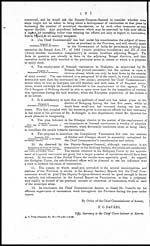Medicine - Vaccination > 1874-1927 - Annual vaccination report of the province of Assam > Vaccination report Assam 1874-1896 > 1889-1890 - Annual vaccination report of the Province of Assam for the year 1889-90
(327) [Page 1]
Download files
Individual page:
Thumbnail gallery: Grid view | List view
![(36) [Page 1] -](https://deriv.nls.uk/dcn17/9152/91525077.17.jpg)
Resolution on the Report on Vaccination in Assam for 1889-90.
Extract from the Proceedings of the Chief Commissioner of Assam in the General
Department, No. 5,909G., dated the 30th July 1890.
READ—
The Annual Vaccination Report for 1889-90.
RESOLUTION.
THIS report was punctually submitted, having been received in manuscript on the
7th June 1890 and in print on the 9th July 1890.
Paragraph 3. Table No 2.
(Progress of vaccination work )
2. The statement which precedes paragraph 3 of the report shows a decided im-
provement over the results of last year in the total number
of operations and in the progress made in all districts
except Cachar, Kámrúp, and the Nága Hills. In the case of Cachar the absence
of the Civil Medical Officer in Lushai-land during two of the cold-weather months
may account for some portion of the decrease, but the Chief Commissioner is not
satisfied that the enormous decrease of nearly 30 per cent., following, as it does,
on a decrease of over 600 cases in the previous year, is thereby sufficiently ex-
plained. The vaccinating staff in the Cachar district has fallen from 18 in the
year 1886-87 to 15 in 1889-90, and to this weakening of the agency available for
vaccination operations a large portion of the unfavourable results may be attributed. The
Chief Commissioner hopes that the Deputy-Surgeon-General, if he concurs in this opinion,
will take measures to strengthen the vaccinating staff of the Cachar district. Lastly,
Mr. Quinton, even after all reasonable allowances are made in connection with the
absence of the civil medical officer during a part of the cold weather, is unable to
acquit Dr. Partridge of remissness in respect of this important branch of his duties.
The prevalence of kála-azár in Kámrúp, which is assigned as a cause for the decrease
of vaccination operations in that district, is much to be regretted, and the special
enquiries into the origin of this disease will, it is to be hoped, by indicating a remedy
for it, remove this indirect effect of the scourge. The prejudices of the people can only
be overcome gradually by tact and judicious pressure on the part of the district and
medical officers, and these remarks apply with special force to the Nága Hills, peopled
by savage tribes, which endeavours are being made to reclaim to civilisation. A
vaccinator among such people requires special qualifications, and the appointment of an
officer so totally wanting in them as the boy referred to in paragraph 11 of the report
evinces a very inadequate conception of his duty by the local medical officer. Profes-
sional qualifications, if unaccompanied by judgment in dealing with men, will do little
to remove the prejudice which obstructs the adoption of a European medical system
by the frontier tribes; and Mr. Quinton requests that the Deputy-Surgeon-General will,
on the occasion of his next inspection, report specially on the qualifications of the medical
officers in the Gáro, Nága, and the Lushai Hills from this point of view.
Paragraph 6, Table No. 4.
(Vaccination on tea-gardens )
3. The increase in the number of operations on tea-gardens, some 40 per
cent. over the figures for the previous year, is satisfactory,
and inspecting officers will be directed not to relax,
during the current year, the attention given to this subject. It is, of course, scarcely
to be expected that the medical employés of the gardens should show as large a propor-
tion of successful vaccinations as the Government establishments, whose attention is
exclusively given to vaccination work.
Paragraph 7. Table No. 5
(Vaccination in compulsory areas.)
4. As regards areas where vaccination is compulsory, Act V. of 1880 (B.C.) being
in force, the figures suggest the conclusion that the results
in the Sylhet and Gauháti Municipalities compare unfavour-
ably with those in the municipality of Dibrugarh. As regards Sylhet, however, it must
be remembered that, according to the Civil Surgeon (paragraph 87 of report), as much as
97 per cent. of the population are already protected by vaccination. This fact would, of
course, go far to explain the smaller number of operations in that municipality. In the
case of Gauháti, it is true that the prevalence of kála, azár has probably exercised the
same indirect influence in retarding vaccination as it is represented to have done in other
portions of the Kámrúp district, but the Chief Commissioner cannot help doubting
whether this explanation is altogether sufficient, so far as the head-quarters station is
Set display mode to: Large image | Zoom image | Transcription
Images and transcriptions on this page, including medium image downloads, may be used under the Creative Commons Attribution 4.0 International Licence unless otherwise stated. ![]()
| Permanent URL | https://digital.nls.uk/91525075 |
|---|
| Additional NLS resources: | |
|---|---|
| Attribution and copyright: |
|
|---|




